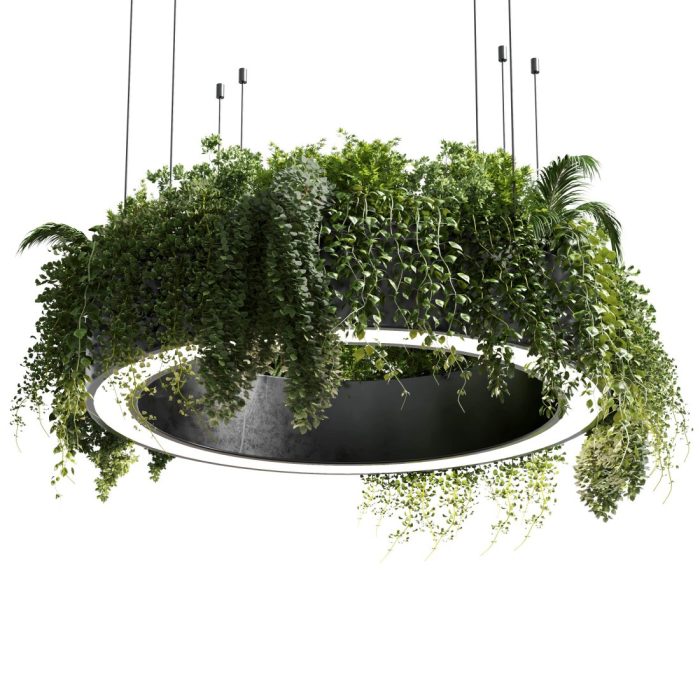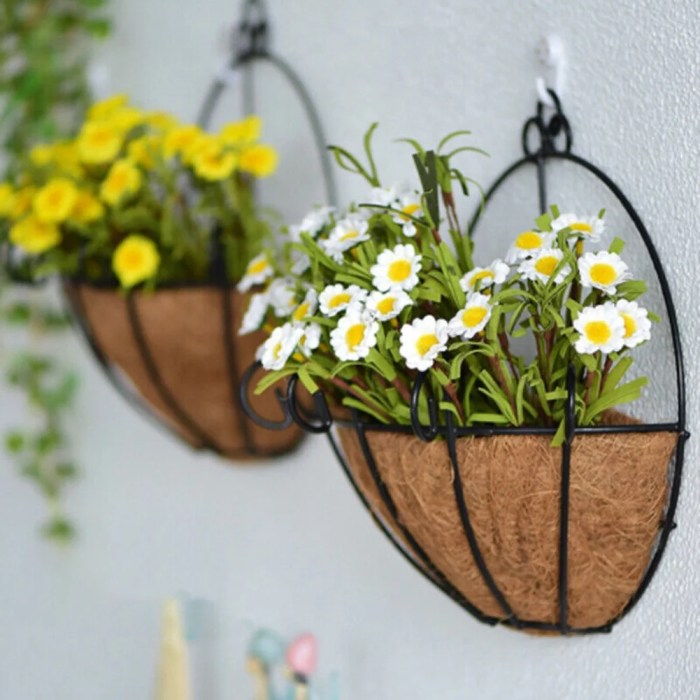Hanging plant lights have emerged as a captivating trend, illuminating both indoor spaces and the well-being of cherished plants. This comprehensive guide delves into the diverse types, selection criteria, installation techniques, and aesthetic considerations of hanging plant lights, empowering readers to create a thriving indoor oasis.
From understanding the specific needs of different plant species to incorporating these lights seamlessly into home décor, this guide provides a wealth of practical advice and inspiration.
Types of Hanging Plant Lights
Hanging plant lights are a great way to provide your plants with the light they need to thrive, even if you don’t have a lot of natural light in your home. There are many different types of hanging plant lights available, so you can choose one that fits your needs and budget.
Some of the most popular types of hanging plant lights include:
- Fluorescent lightsare a good choice for plants that need a lot of light, such as succulents and cacti. They are relatively inexpensive and easy to find, and they provide a bright, even light that is good for plant growth.
- LED lightsare another good choice for plants that need a lot of light. They are more expensive than fluorescent lights, but they are also more energy-efficient and last longer. LED lights also produce less heat than fluorescent lights, which can be beneficial for plants that are sensitive to heat.
- Incandescent lightsare not as good a choice for plants as fluorescent or LED lights, but they can be used in a pinch. They produce a lot of heat, which can damage plants, and they do not provide as much light as fluorescent or LED lights.
Choosing the Right Hanging Plant Light

To select the optimal hanging plant light, it’s crucial to assess the specific requirements of your plants. Factors like light intensity, coverage, and plant species must be taken into account.
Light Intensity
Light intensity, measured in foot-candles (fc), is a critical determinant of plant growth. High-light plants, such as succulents and cacti, thrive under 5,000-10,000 fc. Medium-light plants, like ferns and peace lilies, require 1,000-5,000 fc. Low-light plants, including ZZ plants and snake plants, can tolerate less than 1,000 fc.
Coverage
Coverage refers to the area the light illuminates. It’s essential to ensure the light covers the entire plant canopy to provide uniform growth. The coverage area should be at least 1-2 times the width of the plant.
Plant Species
Different plant species have varying light preferences. Some plants, like African violets, prefer indirect light, while others, like orchids, thrive under direct light. Researching the specific light requirements of your plants will help you make an informed choice.
Installation and Maintenance
Installing and maintaining hanging plant lights is crucial for their optimal performance and longevity. Proper installation ensures safety and efficiency, while regular maintenance prevents malfunctions and extends the life of the lights.
To ensure safety, it is essential to follow the manufacturer’s instructions carefully during installation. Always use the appropriate mounting hardware and ensure the lights are securely attached to the ceiling or other support structure. Avoid overloading the lights with excessive weight or hanging them in areas where they may be subjected to water or moisture.
Safety Precautions
- Follow the manufacturer’s instructions for installation and use.
- Use appropriate mounting hardware and securely attach the lights.
- Avoid overloading the lights or hanging them in areas with water or moisture.
- Inspect the lights regularly for any damage or loose connections.
- Unplug the lights before cleaning or maintenance.
Troubleshooting Tips, Hanging plant light
- If the lights are not turning on, check the power source, wiring, and connections.
- If the lights are flickering, check for loose connections or a faulty power supply.
- If the lights are producing excessive heat, turn them off and allow them to cool before inspecting for any obstructions or damage.
- If the lights are not providing adequate light, adjust the distance between the lights and the plants, or consider using additional lights.
Design Considerations
Hanging plant lights can be a great way to add a touch of greenery and style to your home. But if you’re not careful, they can also look cluttered and out of place. Here are a few tips on how to incorporate hanging plant lights into your home décor:
First, consider the style of your home. If you have a modern home, you might want to choose hanging plant lights with clean lines and a minimalist design. If you have a more traditional home, you might want to choose hanging plant lights with more ornate details.
Placement
Once you’ve chosen the style of hanging plant lights you want, you need to decide where to place them. One popular option is to hang them from the ceiling. This is a great way to create a focal point in a room and to add some height to the space.
You can also hang plant lights from walls or shelves. This is a good option if you don’t have a lot of ceiling space.
Hanging plant light is crucial for the health and well-being of indoor plants. However, for those seeking a low-maintenance option, artificial hanging plants indoor offer a realistic alternative. These artificial plants come in a wide variety of species and sizes, allowing for a lush indoor oasis without the need for natural light or watering.
Moreover, hanging plant light can be effectively utilized to enhance the aesthetic appeal of these artificial plants, creating a vibrant and inviting indoor environment.
Grouping
Another way to incorporate hanging plant lights into your home décor is to group them together. This can create a more dramatic effect and it can also help to fill up a large space. When grouping hanging plant lights, try to use a variety of sizes and shapes.
This will add visual interest to the space.
Benefits of Using Hanging Plant Lights

Hanging plant lights offer numerous benefits for the health and well-being of indoor plants. These specialized lighting solutions provide optimal light conditions, allowing plants to thrive and flourish in environments where natural light is limited or insufficient.
By mimicking the intensity and spectrum of sunlight, hanging plant lights promote optimal growth, enhance photosynthesis, and encourage healthy leaf development. This targeted lighting supports the production of chlorophyll, the green pigment responsible for absorbing light energy and converting it into sugars through photosynthesis.
Hanging plant lights provide ample illumination for hanging plants indoor , promoting their healthy growth and vibrant foliage. These lights are specifically designed to emit the necessary wavelengths of light for photosynthesis, ensuring that indoor plants receive the sunlight they need to thrive.
As a result, plants receive the necessary nutrients and energy for growth, resulting in vibrant foliage and lush greenery.
Improved Air Quality
Hanging plant lights not only enhance plant health but also contribute to improved indoor air quality. Plants naturally absorb pollutants and toxins from the air through their leaves. By providing optimal lighting conditions, hanging plant lights promote the growth and vitality of these natural air purifiers, enhancing their ability to remove harmful substances from the indoor environment.
Conclusion

By embracing the transformative power of hanging plant lights, individuals can not only enhance the health and vitality of their indoor greenery but also elevate their living spaces with a touch of botanical beauty. As this guide concludes, it encourages readers to explore the endless possibilities of hanging plant lights, fostering a harmonious coexistence between nature and design.
FAQ Insights
What are the key factors to consider when choosing a hanging plant light?
Light intensity, coverage area, and the specific light requirements of the plant species are crucial factors to evaluate.
How can I ensure the safe installation of hanging plant lights?
Follow the manufacturer’s instructions carefully, use appropriate mounting hardware, and avoid overloading electrical outlets.
Can hanging plant lights improve indoor air quality?
Yes, plants have natural air-purifying abilities, and providing them with optimal light conditions enhances their capacity to remove pollutants.